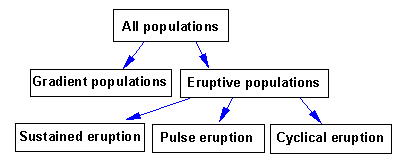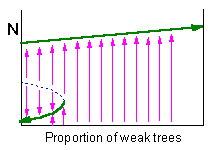Classification of Outbreaks
Classification of insect outbreaks was independently developed by Berryman (1987) and Isaev and Khlebopros (1984).
| Stable High Equilibrium | Unstable High Equilibrium) | |
| Stable Low Equilibrium | Sustained eruption | Pulse eruption |
| Unstable Low Equilibrium | Permanent eruption (no examples) | Cyclical eruption |
Below is the classification of all types of population dynamics (not only outbreak species)

- Gradient populations: respond directly to external factors (no density-dependent amplification). They have high density in favorable conditions and low density in unfavorable conditions (both in space and time). High-density populations never spread (cause population increase in surrounding populations).
- Eruptive populations: the effect of external factors is amplified by inverse density-dependence (=release effect). Amplifying mechanisms were discussed in the first section. Outbreaks of eruptive populations are able to spread (traveling wave). See the spreading outbreak of the southern pine beetle.
- Sustained eruption: environmental fluctuations may cause the transition of the population from the low equilibrium to the high equilibrium. Examples: bark beetles, spruce budworm
- Pulse eruption: environmental fluctuations trigger an outbreak which collapses immediately (e.g., due to parasites). Examples: gypsy moth, pine sawflies, etc.
- Cyclical eruption: Both equilibria are unstable and populations cycles around them. Examples: Zeiraphera diniana, Cardiospina albitextura.
Mechanisms of beetle attack may be different. Bark beetles make holes in the bark. If there are only few beetles, then the holes become filled with resin and beetles die. If thousands of beetles are making their holes simultaneously, then the tree has not enough resin for self-defense.
Sawyer beetles (Monochamus urussovi) oviposit into boles of weakened trees. Adults feed in tree twigs and can weaken a tree if population density is high. As a result, more oviposition sites become available.
 | The figure shows the phase-plot of a bark beetle population. Thick lines are stable equilibria. The high equilibrium is often called "metastable" because the bark beetles eventually destroy their habitat. |


